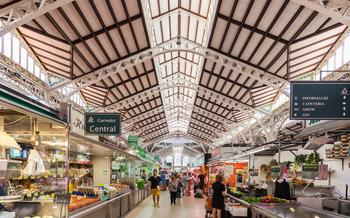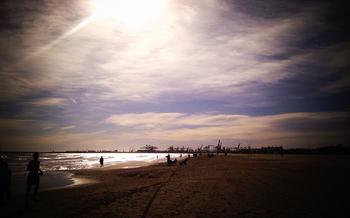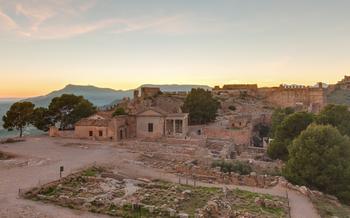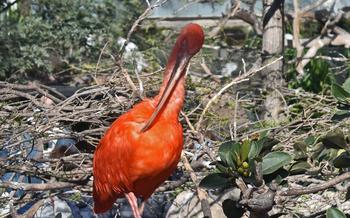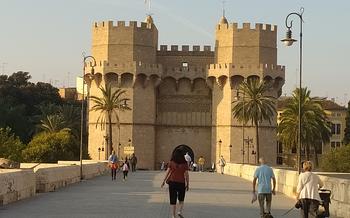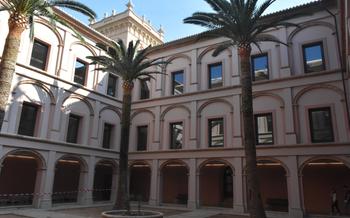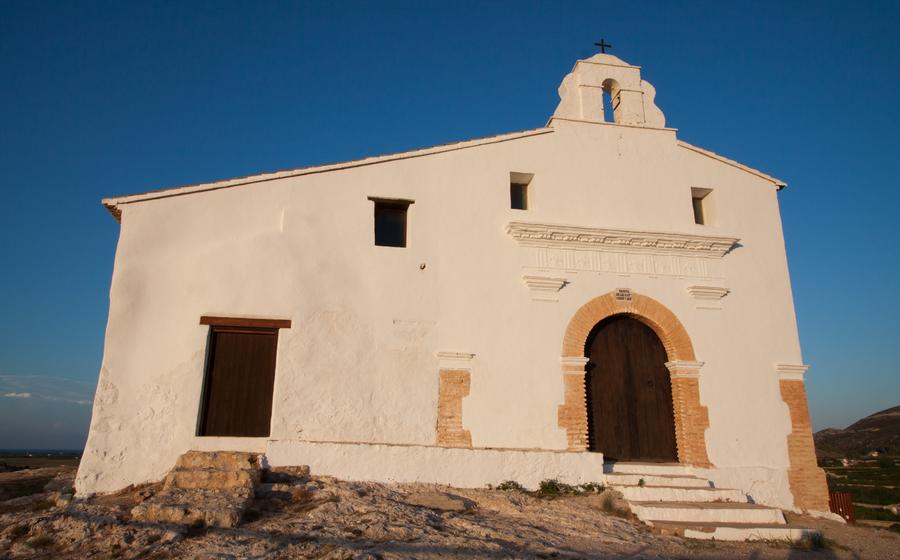
Museo del Arroz
- Museo del Arroz
- History of Rice Cultivation in Valencia
- Varieties of Rice Grown in Valencia
- The Rice Paddy
- Harvesting and Processing Rice
- The Valencian Paella
- Other Rice Dishes from Valencia
- Rice Festivals in Valencia
- Cooking Classes
- Shopping for Rice
- Rice Souvenirs
- Rice Museums in the Valencian Community
- Rice Routes in the Valencian Community
- Insider Tip
Museo del Arroz
The Museo del Arroz, or Rice Museum, is a fascinating institution dedicated to preserving and showcasing the rich history and culture of rice cultivation in Valencia. Established in 1998, the museum is housed in a beautifully restored 18th-century rice mill, known as the Molino de Rafelet, located in the heart of the Albufera Natural Park.
The museum's collection boasts an array of artifacts, machinery, and interactive displays that delve into the intriguing world of rice farming. Visitors can explore the history of rice cultivation in Valencia, from its humble beginnings to its pivotal role in shaping the region's economy and gastronomy. The museum also offers educational activities and workshops, providing a unique opportunity to learn about the significance of rice in Valencian culture.
Located at Carrer Sequiola Mareny, 26, 46012 València, Spain, the Museo del Arroz is easily accessible by public transportation or car. For more information, visit the museum's official website or contact them at (+34) 96 162 00 5
History of Rice Cultivation in Valencia
The history of rice cultivation in Valencia dates back to the 8th century, when the Moors introduced it to the region. The Moors brought with them their advanced irrigation techniques, which allowed them to cultivate rice in the dry climate of Valencia.
Rice quickly became an important crop in Valencia, and by the 15th century, it was the main agricultural product of the region. The cultivation of rice was a major factor in the economic development of Valencia, and it helped to make the city one of the most prosperous in Spain.
In the 19th century, the introduction of new rice varieties and the construction of new irrigation canals led to a further expansion of rice cultivation in Valencia. Today, Valencia is the leading rice-producing region in Spain, and it accounts for over 50% of the country's total rice production.
The rice industry in Valencia is a major employer, and it provides a livelihood for thousands of people. Rice cultivation is also an important part of the Valencian culture, and it is celebrated in many festivals and traditions.
Varieties of Rice Grown in Valencia
Valencia is home to a wide variety of rice varieties, each with its own unique characteristics and flavor profile. The most common type of rice grown in the region is bomba rice, which is known for its ability to absorb a lot of liquid and retain its shape when cooked. This makes it the ideal rice for paella and other Valencian rice dishes. Other popular varieties include senia rice, which is a long-grain rice with a delicate flavor, and gleva rice, which is a short-grain rice with a chewy texture.
Each type of rice has its own specific uses. Bomba rice is the best choice for paella and other dishes where the rice needs to be able to absorb a lot of liquid. Senia rice is often used in soups and salads, while gleva rice is ideal for making risotto and other dishes where a chewy texture is desired.
It is possible to identify the different types of rice by their appearance. Bomba rice is short and round, with a pearly white color. Senia rice is long and slender, with a translucent appearance. Gleva rice is short and round, but it has a more opaque color than bomba rice.
The Rice Paddy
A rice paddy is a flooded field where rice is grown. It is typically a flat, rectangular area that is surrounded by dikes to hold in the water. The water level in a rice paddy is carefully controlled, as it is essential for the growth of the rice plants.
The process of growing rice in a paddy begins with the preparation of the field. The field is first plowed and then leveled. The dikes are then built around the field to hold in the water. The field is then flooded with water, and the rice seeds are sown.
The rice plants grow in the water for several months. During this time, the water level is carefully controlled to ensure that the plants have enough water to grow, but not too much water that they drown. The rice plants also need to be fertilized and protected from pests and diseases.
When the rice plants are mature, they are harvested. The traditional method of harvesting rice is to use a sickle to cut the plants at the base. The plants are then bundled together and dried. The rice is then threshed to separate the grains from the straw.
Modern methods of harvesting rice use machines to cut and thresh the plants. The rice is then cleaned and dried before it is stored.
Rice cultivation is a challenging process, but it is also a rewarding one. Rice is a staple food for many people around the world, and it is an important part of the Valencian economy.
Harvesting and Processing Rice
Rice harvesting in Valencia traditionally involves cutting the mature rice stalks by hand using a sickle. This method, known as "segat", is still practiced in some areas, but it has largely been replaced by combine harvesters. These machines cut the stalks and thresh the grain in one operation.
After harvesting, the rice is transported to a processing facility, where it undergoes several steps to remove impurities and prepare it for consumption. The first step is cleaning, which removes foreign objects such as stones, dirt, and chaff. The rice is then dried to reduce its moisture content.
Next, the rice is milled to remove the husk, the bran layer, and the germ. This process produces brown rice, which still retains some of its nutrients. Brown rice can be eaten as is, or it can be further processed to produce white rice.
White rice is produced by polishing the brown rice to remove the remaining bran layer. This process makes the rice whiter and gives it a longer shelf life. However, it also removes some of the nutrients that are found in brown rice.
After milling, the rice is sorted by size and quality. The highest quality rice is used for human consumption, while the lower quality rice is used for animal feed or other industrial purposes.
By-products of rice processing include rice bran, rice hulls, and rice straw. Rice bran is a nutritious food that can be used in a variety of dishes. Rice hulls are used as a fuel source or as a soil amendment. Rice straw is used as a building material or as animal feed.
The Valencian Paella
The Valencian paella is a world-renowned dish that originated in the city of Valencia. It is a symbol of Valencian cuisine and is considered one of the most important dishes in Spanish gastronomy. The paella is made with rice, chicken, rabbit, green beans, garrofó (a type of white bean), tomatoes, and saffron. It is cooked in a large, shallow pan called a paella pan over an open fire.
The history of the Valencian paella can be traced back to the 15th century. It is believed that the dish was created by farmers who worked in the rice fields of Valencia. These farmers would often cook their lunch over an open fire using the ingredients that were available to them. The paella was a simple and nutritious dish that was easy to prepare and could be shared with a group of people.
Over the years, the Valencian paella has become more elaborate and refined. It is now considered a gourmet dish and is served in restaurants all over the world. However, the traditional recipe remains the same, and the paella is still cooked over an open fire in a large, shallow pan.
The Valencian paella is a delicious and iconic dish that is a must-try for any visitor to Valencia. It is a symbol of the city's rich culinary heritage and a celebration of the Valencian people.
Other Rice Dishes from Valencia
In addition to the famous Valencian paella, there are a number of other delicious rice dishes that can be found in Valencia. Arròs a banda is a seafood rice dish made with a variety of fish and shellfish, such as prawns, mussels, and squid. Arròs negre is a black rice dish made with squid ink, which gives it a distinctive black color. Arròs amb bledes is a rice dish made with Swiss chard, a type of leafy green vegetable. Arròs amb fesols i naps is a rice dish made with beans and turnips. These are just a few of the many rice dishes that can be found in Valencia, each with its own unique flavor and ingredients.
Rice Festivals in Valencia
Valencia is home to a number of rice festivals that celebrate the region's rich rice-growing heritage. These festivals are a great opportunity to learn more about the history and culture of rice cultivation in Valencia, as well as to sample some of the delicious rice dishes that the region has to offer.
One of the most popular rice festivals in Valencia is the Paella Festival, which is held every year in September. The festival features a huge paella cooking competition, as well as live music, dancing, and other entertainment. Another popular festival is the Rice Harvest Festival, which is held in October. The festival celebrates the end of the rice harvest and features a variety of activities, including rice threshing demonstrations, traditional Valencian music and dance performances, and a food market.
If you are interested in learning more about the history and culture of rice cultivation in Valencia, be sure to visit one of the region's many rice festivals. These festivals are a great way to experience the region's vibrant culture and to sample some of its delicious rice dishes.
Cooking Classes
If you want to learn how to cook authentic Valencian rice dishes, there are several cooking classes that you can take. These classes are offered by local chefs and cooking schools, and they provide a great opportunity to learn the secrets of Valencian cuisine.
One popular cooking class is offered by the Paella School Valencia. This class is taught by a professional chef, and it covers the basics of making a traditional Valencian paella. The class includes a hands-on cooking session, where you will learn how to prepare the ingredients, cook the rice, and assemble the paella. You will also learn about the different types of rice that are used in Valencian paella, and the importance of using fresh, local ingredients.
Another popular cooking class is offered by the Valencia Cooking Academy. This class covers a wider range of Valencian rice dishes, including paella, arroz negro, and arroz a banda. The class includes a market tour, where you will learn about the different types of rice and seafood that are used in Valencian cooking. You will also learn how to make a traditional Valencian picada, which is a sauce made from garlic, tomatoes, and almonds.
Cooking classes are a great way to learn more about Valencian culture and cuisine. They are also a fun and rewarding experience, and you will come away with the skills and knowledge to cook delicious Valencian rice dishes at home.
Here are some tips for choosing a cooking class:
- Consider your skill level. There are classes for beginners, intermediate, and advanced cooks.
- Choose a class that covers the dishes you are interested in learning.
- Read reviews of different classes before you book.
- Make sure the class is taught by a qualified chef.
- Book your class in advance, especially if you are traveling during the peak tourist season.
Shopping for Rice
Valencia is a great place to buy rice, as there are many different types available, from the most common varieties to more specialty types. You can find rice in most supermarkets and grocery stores, as well as in specialty food shops.
When shopping for rice, it is important to know what you are looking for. There are many different types of rice, each with its own unique flavor and texture. Some of the most popular types of rice grown in Valencia include Bomba, Senia, and Bahia. Bomba rice is a short-grain rice that is known for its ability to absorb a lot of liquid, making it ideal for dishes like paella. Senia rice is a medium-grain rice that is known for its nutty flavor and firm texture. Bahia rice is a long-grain rice that is known for its light and fluffy texture.
Once you have chosen the type of rice you want, you need to decide how much you need. Rice is typically sold in bags or boxes, and the size of the package will vary depending on the type of rice. It is important to buy enough rice for your needs, as rice can be stored for a long time if it is kept in a cool, dry place.
When you are ready to buy rice, be sure to check the price before you make your purchase. Rice prices can vary depending on the type of rice, the brand, and the store where you are buying it. It is also important to check the expiration date on the package to make sure that the rice is fresh.
Rice Souvenirs
Valencia is a great place to buy rice-related souvenirs. You can find everything from rice cookers and paella pans to rice-shaped chocolates and soaps. Here are a few ideas for rice souvenirs that you can buy in Valencia:
- Rice cookers: If you love cooking rice, a rice cooker is a great way to make perfect rice every time. You can find rice cookers in a variety of sizes and price ranges in Valencia.
- Paella pans: Paella pans are essential for making the perfect paella. You can find paella pans in a variety of sizes and materials in Valencia.
- Rice-shaped chocolates: These chocolates are made in the shape of rice grains and are a delicious treat.
- Rice soaps: These soaps are made with rice extract and are said to be good for your skin.
- Rice-themed kitchenware: You can also find a variety of rice-themed kitchenware in Valencia, such as pot holders, aprons, and placemats.
You can find rice-related souvenirs in a variety of places in Valencia, including souvenir shops, supermarkets, and department stores. The best place to find a wide selection of rice souvenirs is the Mercado Central, which is the largest market in Valencia.
When buying rice-related souvenirs, be sure to choose items that are made in Spain. This will ensure that you are getting high-quality products that will last.
Rice Museums in the Valencian Community
Besides the Museo del Arroz in Valencia city, there are other rice museums in the Valencian Community that are worth visiting. These museums offer a deeper insight into the history, culture, and traditions of rice cultivation in the region.
One of the most notable rice museums is the Museo del Arroz de Cullera, located in the town of Cullera, south of Valencia. This museum showcases the history of rice cultivation in the Cullera region, which is one of the most important rice-growing areas in Valencia. The museum also has a collection of agricultural tools and machinery used in rice cultivation, as well as a replica of a traditional rice mill.
Another interesting rice museum is the Museo del Arroz de Sueca, located in the town of Sueca, north of Valencia. This museum focuses on the history and culture of rice cultivation in the Sueca region, which is another important rice-growing area in Valencia. The museum has a collection of artifacts related to rice cultivation, as well as a replica of a traditional rice paddy.
Both the Museo del Arroz de Cullera and the Museo del Arroz de Sueca offer guided tours in Spanish and English. They also have educational programs for school groups and families.
Rice Routes in the Valencian Community
The Valencian Community is home to several rice routes that allow visitors to learn about the history, cultivation, and gastronomy of this important crop. These routes take visitors to rice paddies, museums, and restaurants, and offer a variety of activities such as rice tasting, cooking classes, and guided tours.
One popular rice route is the Ruta del Arroz de Valencia, which takes visitors to the Albufera Natural Park, one of the most important rice-growing areas in Spain. Visitors can learn about the traditional methods of rice cultivation, visit a rice museum, and sample the local cuisine at a traditional Valencian paella restaurant.
Another popular rice route is the Ruta del Arroz de Alicante, which takes visitors to the Elche-Crevillente Marshes, the second-largest rice-growing area in Spain. Visitors can learn about the history of rice cultivation in the region, visit a rice museum, and sample the local cuisine at a traditional Valencian paella restaurant.
These are just a few of the many rice routes that are available in the Valencian Community. Visitors can find a rice route that suits their interests and budget, and learn more about this important part of Valencian culture.
Insider Tip
To get the most out of your visit to the Museo del Arroz, be sure to take part in one of the educational activities offered by the museum. These activities are designed to teach visitors about the history and importance of rice cultivation in Valencia. They are also a great way to learn about the different varieties of rice grown in the region and how to cook them. The museum offers a variety of activities for all ages, so there is sure to be something for everyone.
